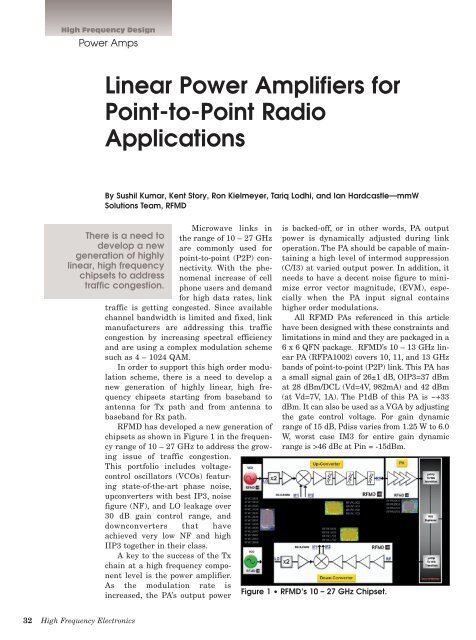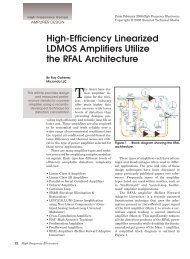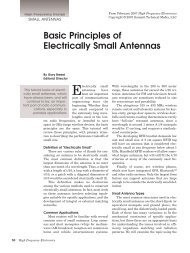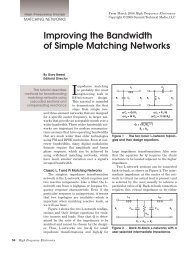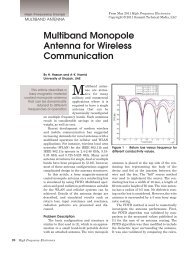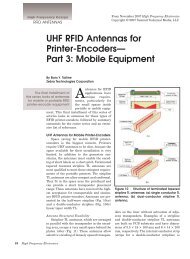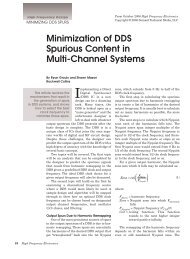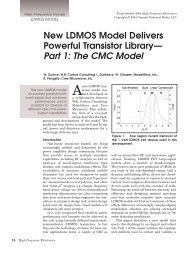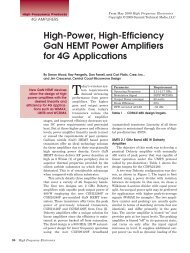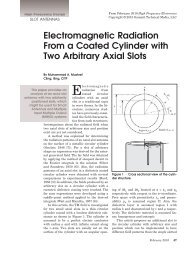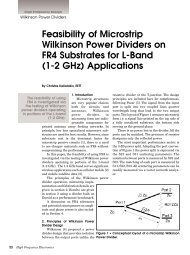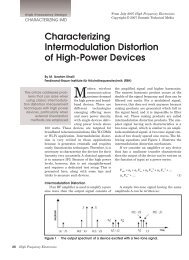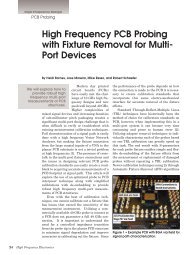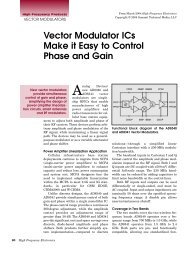Linear Power Amplifiers - High Frequency Electronics
Linear Power Amplifiers - High Frequency Electronics
Linear Power Amplifiers - High Frequency Electronics
You also want an ePaper? Increase the reach of your titles
YUMPU automatically turns print PDFs into web optimized ePapers that Google loves.
<strong>High</strong> <strong>Frequency</strong> Design<br />
<strong>Power</strong> Amps<br />
<strong>Linear</strong> <strong>Power</strong> <strong>Amplifiers</strong> for<br />
Point-to-Point Radio<br />
Applications<br />
By Sushil Kumar, Kent Story, Ron Kielmeyer, Tariq Lodhi, and Ian Hardcastle—mmW<br />
Solutions Team, RFMD<br />
Microwave links in<br />
There is a need to the range of 10 – 27 GHz<br />
develop a new are commonly used for<br />
generation of highly point-to-point (P2P) connectivity.<br />
With the phe-<br />
linear, high frequency<br />
chipsets to address nomenal increase of cell<br />
traffic congestion. phone users and demand<br />
for high data rates, link<br />
traffic is getting congested. Since available<br />
channel bandwidth is limited and fixed, link<br />
manufacturers are addressing this traffic<br />
congestion by increasing spectral efficiency<br />
and are using a complex modulation scheme<br />
such as 4 – 1024 QAM.<br />
In order to support this high order modulation<br />
scheme, there is a need to develop a<br />
new generation of highly linear, high frequency<br />
chipsets starting from baseband to<br />
antenna for Tx path and from antenna to<br />
baseband for Rx path.<br />
RFMD has developed a new generation of<br />
chipsets as shown in Figure 1 in the frequency<br />
range of 10 – 27 GHz to address the growing<br />
issue of traffic congestion.<br />
This portfolio includes voltagecontrol<br />
oscillators (VCOs) featuring<br />
state-of-the-art phase noise,<br />
upconverters with best IP3, noise<br />
figure (NF), and LO leakage over<br />
30 dB gain control range, and<br />
downconverters that have<br />
achieved very low NF and high<br />
IIP3 together in their class.<br />
A key to the success of the Tx<br />
chain at a high frequency component<br />
level is the power amplifier.<br />
As the modulation rate is<br />
increased, the PA’s output power<br />
is backed-off, or in other words, PA output<br />
power is dynamically adjusted during link<br />
operation. The PA should be capable of maintaining<br />
a high level of intermod suppression<br />
(C/I3) at varied output power. In addition, it<br />
needs to have a decent noise figure to minimize<br />
error vector magnitude, (EVM), especially<br />
when the PA input signal contains<br />
higher order modulations.<br />
All RFMD PAs referenced in this article<br />
have been designed with these constraints and<br />
limitations in mind and they are packaged in a<br />
6 x 6 QFN package. RFMD’s 10 – 13 GHz linear<br />
PA (RFPA1002) covers 10, 11, and 13 GHz<br />
bands of point-to-point (P2P) link. This PA has<br />
a small signal gain of 26±1 dB, OIP3=37 dBm<br />
at 28 dBm/DCL (Vd=4V, 982mA) and 42 dBm<br />
(at Vd=7V, 1A). The P1dB of this PA is ~+33<br />
dBm. It can also be used as a VGA by adjusting<br />
the gate control voltage. For gain dynamic<br />
range of 15 dB, Pdiss varies from 1.25 W to 6.0<br />
W, worst case IM3 for entire gain dynamic<br />
range is >46 dBc at Pin = -15dBm.<br />
Figure 1 • RFMD’s 10 – 27 GHz Chipset.<br />
32 <strong>High</strong> <strong>Frequency</strong> <strong>Electronics</strong>


